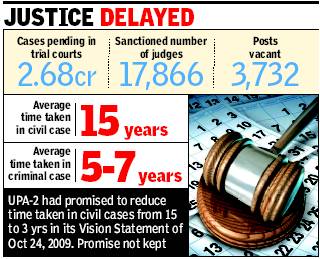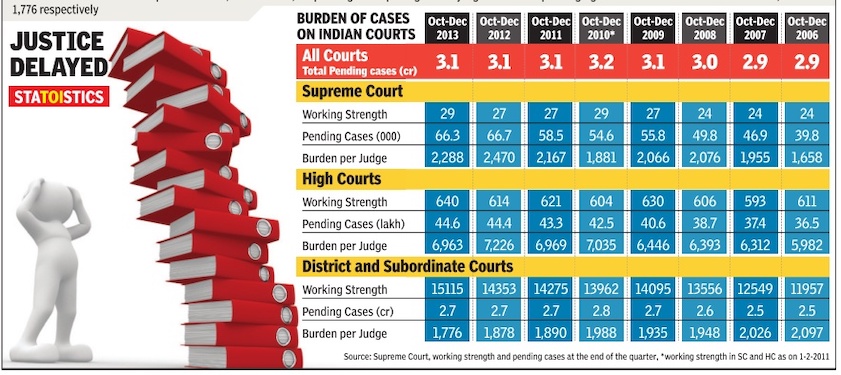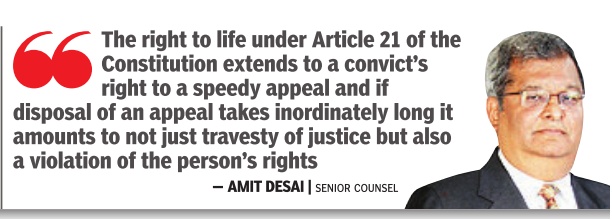Judicial delays/ pendency: India
This is a collection of articles archived for the excellence of their content. Readers will be able to edit existing articles and post new articles directly |
Contents |
Supreme Court on pending cases
Curb adjournments, speed up trials, SC tells lower courts
‘Law Being Violated With Impunity’
Dhananjay Mahapatra The Times of India 2013/05/15
At a time when people are getting impatient with judicial delays, the Supreme Court has stepped in to curb the tendency of trial courts to liberally grant adjournments at the instance of lawyers. It said that trial courts were flouting “with impunity” the Criminal Procedure Code mandate for conducting proceedings on a day-to-day basis after witness examination starts and were easily granting adjournments.
A bench of Justices K S Radhakrishnan and Dipak Misra expressed “anguish, agony and concern” over adjournments granted by a Punjab trial court in a bride burning case which stretched the process of examination of witnesses to more than two years.
“On perusal of dates of examination-in-chief and crossexamination, it neither requires Solomon’s wisdom nor Argus eyes (mythological giant with 100 eyes) scrutiny to observe that the trial was conducted in an absolute piecemeal manner as if it was required to be held at the mercy of the counsel,” Justice Misra, who authored the judgment, said.
Referring to Section 309 of the CrPC, the bench said once a case reached the stage of examination of witnesses, the law mandated that it “shall be continued from day-to-day until all witnesses in attendance have been examined”. The section provides that if for some unavoidable reason the court was to grant adjournment, it must record its reasons in writing.
‘Trial judge can’t be a mute spectator to litigants’ tactics’
The Supreme Court expressed its anguish over the tendency of trial courts to liberally grant adjourments. “It is apt to note here that this court expressed its distress that it has become a common practice and regular occurrence that the trial courts flout the legislative command with impunity,” the bench of Justices K S Radhakrishnan and Dipak Misra said.
The bench added that the criminal justice dispensation system casts a heavy burden on the trial judge to have full control over the proceedings. “The criminal justice system has to be placed on a proper pedestal and it can’t be left to the whims and fancies of the parties or their counsel.”
“A trial judge cannot be a mute spectator to the trial being controlled by the parties, for it is his primary duty to monitor the trial and such monitoring has to be in consonance with the CrPC ,” the bench said. The SC wanted trial judges to keep in mind the mandate of the CrPC and not get guided by their thinking.
“They cannot abandon their responsibility. It should be borne in mind that the whole dispensation of criminal justice system at the ground level rests on how a trial is conducted. It needs no special emphasis to state that dispensation of criminal justice system is not only a concern of the bench but has to be the concern of the bar,” it said.
On the case of bride burning and ill-treatment meted out to daughters-in-law, the apex court said, “A daughter-in-law is to be treated as a member of the family with warmth and affection and not as a stranger with despicable and ignoble indifference. She should not be treated as a housemaid. No impression should be given that she can be thrown out of her matrimonial home at any time.”
The Times of India’s View
Given the enormous backlog of cases in Indian courts, particularly at the lower levels, any measure that helps speed up processes is welcome. Getting rid of needless adjournments is certainly an important step and the Supreme Court must be thanked for stepping in to curb them. We hope that the implementation of this directive will be rigorous.
SC blames HCs for delay in hearing criminal cases
Apex Court Finds 2,280 Cases Of Rape, Murder Stayed By HCs
Dhananjay Mahapatra | TNN
From the archives of The Times of India 2007, 2009
New Delhi: Ever wondered why so many accused in heinous crimes — murder, rape, kidnapping and dacoity — roam around for years before the law catches up with them?
This question bothered the Supreme Court a lot and it found that the High Courts were mainly responsible for such a sorry state of affairs. For, they have stayed the proceedings in these cases and forgotten all about them for years.
As many as 2,280 cases relating to murder, rape, kidnapping and dacoity have been stayed by HCs at various — FIR, investigation, framing of charges and trial — stages and then left in the limbo, possibly allowing the accused to remain at large on bail.
A Bench comprising Justices G S Singhvi and A K Ganguly sought assistance from Solicitor General Gopal Subramaniam for collating data on cases relating to the four categories of heinous crimes which have been stayed by HCs after it found an identical situation pointed out in a petition filed by Imtiaz Ahmed, where the Allahabad HC had stayed a criminal case since April 2003.
The efforts by the SG to collate such cases threw up startling facts:
Murder cases stayed at various stages by HCs were 1,021 (45% of the total cases), rape cases 492, kidnapping cases 550 and dacoity 217
As many as 41% of the 2,280 cases were pending for 2-6 years and 8% for more than 8 years. Of a total of 178 cases pending for more than 6 years, 97 were murder cases
Calcutta High Court appears to be the most liberal when it came to staying cases relating to heinous crimes accounting for 31% of the 2,280 cases. Allahabad High Court was not far behind having stayed 29% of the cases
In most of the cases across the HCs, the duration for which the case is pending varied from 1 to 4 years. It is seen that 34 out of 201 cases in Patna HC and 33 out of 653 cases in Allahabad HC were pending for more than 8 years
After perusing the enormity of the situation and having regard to the case in hand that related to Allahabad HC, the Bench headed by Justice Singhvi requested the counsel for the High Court to furnish data about the number of cases which have been stayed at the stage of investigation or trial and listed the matter for further hearing on July 9.
The report was submitted to the court by Subramaniam, who took assistance of Dr Pronab Sen and Dr G S Manna, secretary and deputy director in the ministry of statistics and programme implementation, in studying the data supplied by various HCs.
The SG, in the concluding part of the report, said “the fact-finding exercise by the Supreme Court has revealed a problem of serious dimension” and suggested that the apex court would be well within its jurisdiction to direct the HCs to dispose of the matter within a year from the date of grant of stay in cases relating to heinous crimes.
If a case was not disposed of within a year, the concerned judge must record the reasons which should be communicated to the concerned chief justice of the HC, Subramaniam suggested.
SC: ‘Flood of appeals affecting verdicts’
From the archives of The Times of India 2010
Pressure Does Not Give Judges Enough Time To Deliberate Upon Cases: SC
Dhananjay Mahapatra | TNN
New Delhi: A concern expressed in hushed voices by senior lawyers for quite some time in the corridors of the apex court has now become official.
The Supreme Court has admitted that deluge of appeals is affecting the quality of its judgments, which are abided by all and sundry as the law of the land.
It does not want the apex court, set up to decide constitutional issues and inter-state disputes in addition to giving opinion to the President on tricky legal questions, to get reduced to just a final court of appeal being mired in the volumes.
To devise a way out of the jungle of files eating into judicial time and affecting the quality, a bench comprising Justices Markandey Katju and R M Lodha said the time has come for a Constitution bench to firmly lay down guidelines as to the categories of cases that the apex court should entertain rather than get engaged in deciding routine appeals or mundane issues.
The judgment comes at a time when a flood of appeals in the last four years has given rise to huge pendency in the Supreme Court, which for the first time in a decade reported a backlog of over 50,000 cases in March last year. Since then it has been on the increase and on January 1, 2010, the pendency stood at 55,791 cases.
Searching for a solution, the bench found the suggestions of senior advocate K K Venugopal quite valuable. Venugopal in a recent speech had said that the SC should deal with five categories of cases — those involving interpretation of the Constitution, matters of national and public importance, validity of laws, judicial review of constitutional amendments and settling difference of opinion between high courts.
On its own it added two more categories — where there is a grave miscarriage of justice and where a fundamental right of a person is prima facie violated.
It said: “The apex court lays down the law for the whole country and it should have more time to deliberate upon the cases it hears before rendering judgments.”
“However, sadly the position today is that it is under such pressure because of the immense volume of cases in the court that judges do not get sufficient time to deliberate over the cases, which they deserve, and this is bound to affect the quality of out judgments,” the bench said.
It issued notices to the SC Bar Association, Bar Council of India and the SC Advocates on Record Association to assist the constitution bench in framing appropriate guidelines to limit the flooding of appeals.
With the computerization of the Supreme Court registry and use of information technology in the docket management, the pendency of the cases in the 1990s was brought down from over one lakh to a manageable 20,000.
But, the rush of litigants, despite an increased disposal rate, has proved more than a match for the judges, who despite hearing nearly 80 cases per day have not been able to bring it down.
The pendency started creeping northwards since 2006, when it stood at 34,649. In January 2007, it became 39,780 while it registered a steep jump to 46,926 in January 2008.
By the start of 2009, it was within handshake distance of the 50,000-mark as the pending cases numbered 49,819. The half-a-lakh pendency mark was crossed on March 31, 2009.
Region-wise
Trial courts: Delhi, delays reducd
Case backlog shrinks in trial courts
30% Reduction Since 2011-End, But No Change In Number Of Criminal Cases
Smriti Singh TNN
The Times of India 2013/08/13
New Delhi: Trial courts in the capital have managed to reduce pending cases by 30% in the last one-and-a-half years. A recent report released by the Delhi district courts on the pendency of cases states that around five lakh cases are pending before the lower judiciary this year as against more than seven lakh at the end of 2011. This figure includes all the criminal cases and civil disputes before the magisterial courts and the district and sessions courts.
There has also been a significant reduction of 50% in the pending cases of dishonoured cheques, major component of the backlog. From 2.2 lakh cheque bounce cases pending in 2011, the courts now have 1.06 lakh. Legal experts say the drop in pending cases is a result of measures adopted by the judiciary, such as the setting up of special courts and the ‘five-plus-zero’ initiative.
Last year, the Delhi high court had asked judges to “identify” cases which have been pending for more than five years and take them up on priority. They were also asked to dispose of such cases within six months.
The circular issued by the HC had also asked the courts to bring down the pendency of ‘cheque bounce’ cases under the Negotiable Instruments Act by 50% before December 2012. To achieve the target, the senior judges were asked to “ensure” that the metropolitan magistrates dealing with such cases are provided with “adequate staff and support from police stations in executing summons and warrants”.
While the targets in the cheque dishonour and traffic challan cases seem to have been achieved, there is no decline in the number of criminal cases pending before the sessions courts. In all, 18,564 sessions-triable cases, which have a punishment of seven years and above, are pending. This figure includes 1,043 rape cases, 47 cases of gang rape and 212 cases pending under the new Protection of Children from Sexual Offences Act (POCSO).
Even as six fast-track courts have been set up to try cases of sexual offences against women, sources said it is difficult to bring down the pendency in such cases to zero due to the increasing crime rate. “Pendency in criminal cases usually stays constant as new cases are filed every day, and despite regular disposal the new cases add on to the existing numbers,” said a judge on the condition of anonymity.
Also, adding to this year’s backlog are more than 1 lakh cases pending before magisterial courts. These include petty offences in which the maximum punishment is up to three years.
Sources say many measures have been adopted by the courts to tackle the mounting number of cases. Besides the five-plus-zero initiative and the increased number of judges in the lower judiciary, the courts are also required to send their disposal rate in every quarter of the year. Mega lok Adalats are also being held on a regular basis to deal with compoundable offences—those in which a settlement can be achieved.
320 years to clear the backlog
From the archives of The Times of India 2010
‘It’ll take 320 years to clear legal backlog’
TIMES NEWS NETWORK
Hyderabad: It will take the Indian judiciary 320 years to clear the backlog of 31.28 million cases. The staggering admission came on Saturday from someone who knows the way the courts work all too well — Justice V V S Rao of the Andhra Pradesh high court.
‘‘If one considers the total pendency of cases in the Indian judicial system, every judge in the country will have an average load of about 2,147 cases,’’ Justice Rao said. India has 14,576 judges as against the sanctioned strength of 17,641, working out to a ratio of 10.5 judges per million population, he said. In 2002, the Supreme Court suggested it be 50.
‘Court cases increase with rise in literacy’
Hyderabad: It will take the Indian judiciary 320 years to clear the backlog of 31.28 million cases, says Justice V V S Rao of the Andhra Pradesh high court. If the norm of 50 judicial officers per million becomes a reality by 2030 when the country’s population would be 1.5 to 1.7 billion, the number of judges would go up to 1.25 lakh dealing with 300 million cases. A recent study indicated that the number of new cases has direct relationship with increasing literacy rate and awareness, the judge said.
Citing the example of Kerala, a high literacy state, Justice Rao said with awareness, 28 new cases per 1,000 population per annum have been added, whereas in Bihar, the figure stands at just three, he said. He summed up the Indian situation by quoting from the journal of International Law and Politics which said: ‘‘The typical lifespan of a civil litigation in India presents a sad picture. Records of new filings are kept by hand and documents filed in court house are frequently misplaced or lost.’’ TNN
2012 to 2014: Pendency in subordinate/ district courts
The Times of India, Jan 08 2016

UP lower courts show the way in disposing of cases
More Than 3cr Cases Pending In HCs, Subordinate Courts
The performance of subordinate judiciary in UP , surprisingly , has mproved considerably compared to other states. Last month they had disposed of 1,04,425 cases as against 76,479 new ones registered. The rate at which pendency has been reduced in the last three years has been impressive too. The disposal of cases by he subordinate and district courts in UP has gone up by almost 2 lakh a year in the last hree years -from 27.98 lakh cases disposed of in 2012 to 31.82 lakh in 2014. Among other states, Karnataka and Kerala have also shown better performance during this period where disposals have gone up from 10.35 lakh to 13.67 lakh cases and 11 lakh to 13.55 lakh cases, respectively.
Maharashtra, Madhya Pradesh and Tamil Nadu are among those which need to further strengthen their court procedure, to avoid being tagged laggards. The subordinate courts in Maharashtra had disposed of 20.48 lakh cases in 2012, which has come down to 15.36 lakh cases in 2014. Similar is the rend in MP and Tamil Nadu.
The statistics released by he law ministry recently indicate the performance of subordinate judiciary has overall improved in the last ew years. In comparison, the rend in 24 High Courts together show a dismal per ormance. More than 3 crore cases are pending in HCs and subordinate courts together -41.50 lakh in HCs and 2.64 crore in subordinate and dis rict courts across the coun ry. UP still remains at the top with highest number of pendency at 48 lakh cases, fol owed by Maharashtra, Gujarat, West Bengal and Bihar.
Pending cases, 2006-13
Apr 06 2015
Perhaps one of the biggest challenges faced by the Indian judiciary is the massive burden of pending cases. As of the last quarter of 2013, there were over 3 crore pending cases in various courts. In the eight years between 2006 and 2013, the number of pending cases increased at each level of courts. The increase, however, is steeper at the higher levels compared to district and subordinate courts. Also, the burden of cases per judge has increased in the SC and HCs while it has decreased in district courts. As of the last quarter of 2013, there were 6,963 pending cases per high court judge. The corresponding figures for SC and district courts were 2,288 and 1,776 respectively.
2014
Jan 13 2015
COURTING TROUBLE
Indian courts are known for the colossal pile of pending cases. According to the latest data available on the Supreme Court website, there are about 31.9 million pending court cases in India, more than the population of countries like Saudi Arabia, Malaysia and so on. The data also shows that there are sizeable number of vacancies at all levels of courts -19.4% in the Supreme Court, 29.2% in high courts and about 22% in various district and subordinate courts. Among high courts, the Allahabad HC has the highest number of pending cases followed by Madras and Bombay. At lower levels, the highest pendency is in Uttar Pradesh
2015: Pendency 45 lakh in 24 HCs
The Times of India, Oct 15 2015
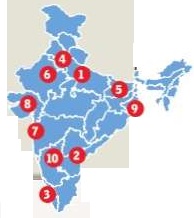
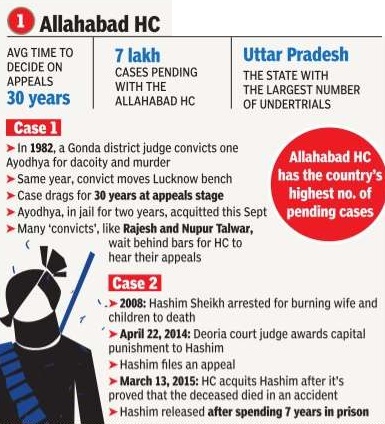





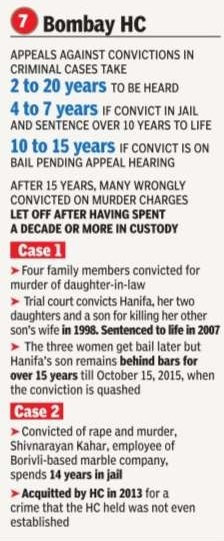

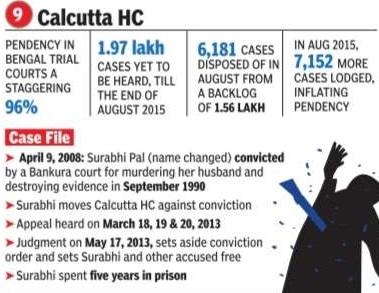
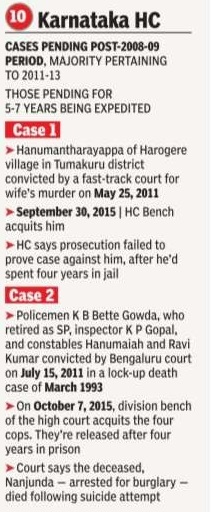
The wheels of justice, the saying goes, grind slowly but grind exceedingly fine. In the Indian context, it would be more true to say that they grind so exceedingly slowly that there can be nothing fine about the outcome. When we set out to look at instances of gross miscarriage of justice, we found several cases where people were convicted of heinous crimes and locked up for years before being found innocent on appeal. Given the state of our high courts, this is hardly surprising. Consider the cold statistics first. As of end of June 2014, there were nearly 45 lakh cases pending in the country's 24 high courts. That's an average of nearly 2 lakh cases per high court. This is mindboggling in itself, but pales in comparison to the situation in Allahabad HC, where approximately 7 lakh cases are pending.
The extent of pending cases is only to be expected when you look a little deeper into the same official data. It also tells you that as of end of June 2014, there were 265 vacancies for judges in the HCs against a sanctioned strength of 906, a shortfall of almost 30%. In the case of Allahabad HC, 70 of 160 positions were vacant or, about 44% of the judges required for the voluminous work have not been appointed.
Of the cases pending, about 10.3 lakh in all the HCs and 3.5 lakh in Allahabad alone were criminal cases. Assume for argument's sake that just one in a hundred of these cases will end up in the acquittal of the person or persons convicted by the lower courts -the actual acquittal rate will, of course, be much higher, but even if 1% of those convicted is innocent -then over 10,000 people in the country are wrongly locked currently . They are in jail despite being innocent of the crime they are said to have committed. For a system supposedly based on the principle that it is better for ten guilty people to go scot-free than for one innocent to be wrongly convicted, that is a shocking statistic.
It isn't as if a person who has been wrongly convicted can count on a quick reprieve on appeal. In Allahabad HC, for instance, it takes, on average, 30 years for appeals against conviction in a lower court to be decided. The Rajasthan HC also has criminal cases pending since 1985. In Bombay HC, you could wait anywhere between two and 20 years, but the average time it takes for an appeal to be heard is four to seven years if a convict is in jail and the sentence is over 10 years; and 10-15 years if the convict is on bail pending the appeal hearing.
The exact period of waiting may vary from HC to HC, but in most cases it runs into several years. And if the crime involved is murder, the wrongfully convicted person will be serving time while he or she waits. And for a very long time.By the time they are acquitted, most have wasted their best years in conviction. If this isn't travesty of justice, what is? Here are some real cases. One Ayodhya was convicted by the Gonda district judge for dacoity and murder in 1982 and appealed promptly . He was finally acquitted in September this year after having been in jail for two years and 30 more years under the shadow of a wrongful conviction though out on bail. Getting employment or social acceptance in this period must have been next to impossible. Kanem Anjamma of East Godavari in Andhra was convicted in January 2010 along with her husband for murdering their neighbour G Nageswara Rao neighbour G Nageswara Rao in 2007. Locked up for over five years, Anjamma finally was acquitted by HC in June this year. Kavita Sharma and her alleged paramour, Krishna Kumar Sain, were arrested in 2004 for murdering Kavita's husband and convicted by the trial court in 2006. In July this year, the Rajasthan HC acquitted them. They had spent 11 years in jail.
The loss of their freedom apart, each of these people had to carry the stigma of being criminals and murderers and in most cases by the time the grinding wheels of justice spat out their final verdict, there really wasn't much of a life to return to. That these are not isolated cases, but are illustrative of a deep malaise, is evident from the statistics on pendency of cases. The adage about justice delayed being justice denied has never been truer or more powerfully brought home.
(With bureau inputs from states)
The Times of India’s View
The Times of India, Oct 15 2015
The provision of justice is among the most basic of services the state is expected to render to its citizens. The data here makes it abundantly clear that the Indian state has failed miserably in discharging this duty. At a time when all reasoned opinion says India needs more judges at every level than it currently has, how can the state escape the responsibility for vacancies of the order of about 20% in the Supreme Court, 30% in the high courts and nearly 22% in the lower courts?
Almost every week, there's a report in this paper of someone being found innocent by the courts -but only after he she has spent years and years in jail. This Sunday, we carried a report of the Bombay HC declaring a person not guilty of murder -14 years after he had been thrown behind bars, eight of them while his appeal was pending. In many such long-pending cases, the defendants are abjectly poor and cannot afford bail, forget a decent lawyer. Some of them don't even come to trial for years though theirs are relatively minor infractions of the law such as pickpocketing; it's not uncommon for undertrials to spend more time in jail than the maximum term they would have got if convicted. It's almost as if these people are forgotten once they're thrown behind bars.
Since it is the state's negligence that is largely responsible for such delays, it is only fair it compensates those found to have been wrongfully confined if their appeal has taken more than a stipulated time to decide or the appeals court holds that the earlier conviction was a case of very poor judicial judgement. It cannot undo the years of freedom they've lost, or the damage to their reputation, but it can bring some support to those who've lost years of their working lives in jail. At the very least, it should pay Rs 50 lakh for every year lost, to someone who had no income. For those with modest incomes the amount should be Rs 1 crore per year, Rs 3 crore per year for those with middling incomes and Rs 7 crore-Rs 10 crore per year for those in higher income brackets. These sums may appear high, but remember they include both compensation for irreparable harm and an element of deterrence for wrongful confinement or tardy administration of justice.
There should be fast-tracking of appeals, at least in cases like the Aarushi murder. Someone might legitimately ask why the Talwars should receive `preferential treatment'. It is possible that in many other cases waiting to be heard, the collection of evidence and police investigation was shockingly slipshod -as in the Aarushi case -and due process of law not followed. So why should the Talwars not have to wait like everybody else? It's because they've been convicted of murdering their daughter in a case where the unanswered questions are too glaring and too many to ignore. There can be no fate worse than that of parents who may have been wrongfully convicted of their child's murder.First, the grief of losing a child in gruesome circumstances, and then being viewed as murderers by the world. An expeditious hearing is all they seek -and it should be granted.
In the end, the entire system needs to be fixed, and soon.How many years more will we let countless thousands rot in jail -away from home and family -for crimes they haven't committed? More than these people, it is the state and the criminal justice system on trial here.
Compensating for lost years
The Times of India, Oct 15 2015
In most developed countries, a wrongful conviction can lead to the aggrieved person seeking huge compensations. The reason is despite their proven innocence, those convicted find the odds of relocating themselves in society difficult. It's for this that such countries claim an obligation to facilitate financial compensation to the wrongfully convicted.
In our country, the only reward for wrongful conviction is release from prison, never mind if the life of that person has been destroyed after years and sometimes decades in prison, for no fault of theirs.
TOI looks at the state of justice -rather its miscarriage -that is unwittingly functioning towards a more criminalized society than a `humanistic' one. The old aphorism, “Let justice be done though the heavens fall,“ is turned on its head in our country, where the heavens fall on countless innocents who await the assistance of a system that wrongfully convicted them.
Pending undertrials
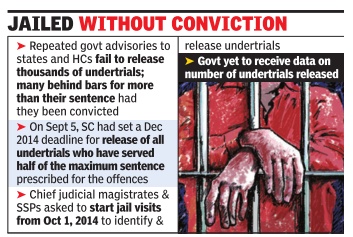
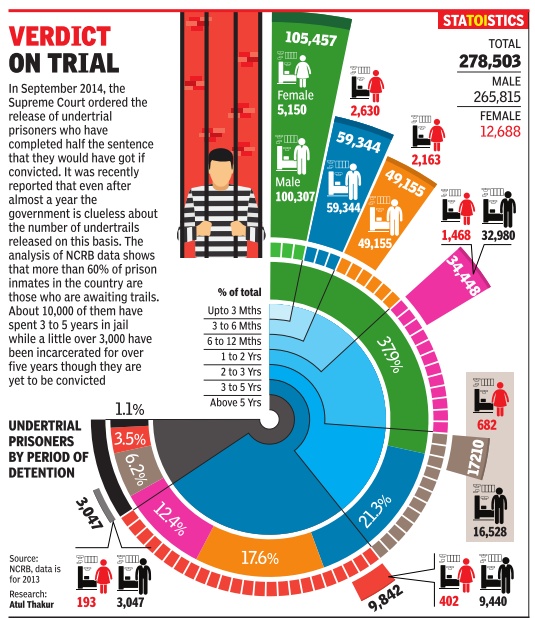
May 08 2015
Pradeep Thakur
At least 2.54 lakh undertrials, many of whom may be innocent, are made to languish behind bars for their failure to procure bail. It has been estimated that out of 3.81 lakh prisoners across the country , about 2.54 lakh are undertrials. Only one-third, or 1.27 lakh, of those in jail have been convicted and are serving their sentence. In British India, the ratio of undertrials to convicts was just the reverse, where two-thirds of the prison population was of convicts. According to the government's own assessment, many of these undertrials have spent more time in jail than the sentence they would have got had they been convicted for the crime they were arrested for, which is against the law of the land.
Some of these undertrials are petty thieves and ragpickers and can't afford bail bond.In many cases, undertrials have been jailed for more than a decade without cases being listed for trial. In September 2014, the SC had set a deadline of December 2014 to release all undertrials who had served half of the maximum sentence prescribed for the offences they had been charged with in FIR against them on personal bond. Prior to the SC order, the home ministry too had issued advisories to states and all 24 HCs asking them to ensure implementation of Section 436A of the Code of Criminal Procedure that mandates release of such undertrials.
But this was not the first time that the government had raised the matter with state governments and high courts and brought to their notice the CrPC provisions. “Such advisories were sent to state governments and HCs earlier to implement the amendment brought in CrPC but this was never followed,“ a source said.
60% of undertrials spend more than three months in jail

May 11 2015
Deeptiman Tiwary
According to government data, over 60% of undertrials spend more than three months in jail before they can secure release. The prolonged incarceration is due to the inability of these undertrials to get bail.
Close to 1.75 lakh of 2.78 lakh people facing criminal charges are unable to secure bail before three months. Over 40% (1.1 lakh) of undertrials take more than six months to secure bail, while over 30,000 spend more than two years and over 64,000 spend more than a year in jail before they are released on bail.
The figures point to a deeper malaise in the criminal justice system as bail, pending conviction, is considered a right under Indian law. Even in cases of heinous nature, an undertrial is entitled to bail, if not immediately, then after a chargesheet is filed by an investigating agency . Police get three months to file charges in cases under the Indian Penal Code and up to six months under special laws such as Unlawful Activities Prevention Act and Maharashtra Control of Organized Crime Act.
The fact that over 60% are incarcerated even after charges are filed points to the fact that only those with deep pockets to hire talented lawyers and fight long-drawn legal battles are able to secure bail.
Colin Gonsalves of Human Rights Law Network said that though bail was a right of every individual, it was largely available to the rich. “When it comes to rich people, the court has double standards. The rich even get anticipatory bail. Salman's case is a shocking case of miscarriage of justice and consideration based on class. First, it's a fit case where he should have got 10 years in jail. Two, why should his bail plea be heard expeditiously when there are hundreds such applications pending in high courts. Why should he be allowed to jump queue? It sets a bad precedent,” he told TOI.
